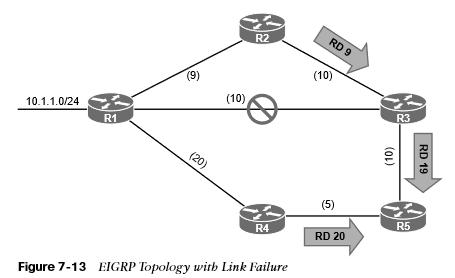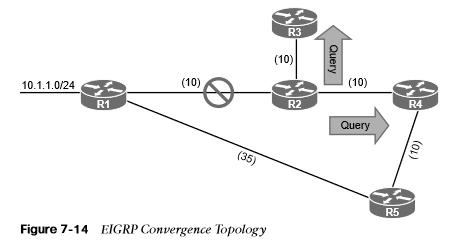
About Lesson
EIGRP Failure Detection and Timers
how EIGRP detects the absence of a neighbor and the convergence process.
- A secondary function for the EIGRP hello packets is to ensure that EIGRP neighbors are still healthy and available. EIGRP hello packets are sent out in intervals determined by the hello timer.
- EIGRP uses a second timer for the hold time, which is the amount of time EIGRP deems the router reachable and functioning. If the hold time reaches 0, EIGRP declares the neighbor unreachable and notifies DUAL of a topology change.
- The default EIGRP hello timer is 5 seconds, but it is 60 seconds on slow-speed interfaces (T1 or lower). The hold time value defaults to 3 times the hello interval.
Convergence
- When an EIGRP neighbor moves to a down state, paths are recomputed for any prefix where that EIGRP neighbor was a successor (upstream router). When EIGRP detects that it has lost its successor for a path, the feasible successor instantly becomes the successor route. The router sends out an update packet for that path because of the new EIGRP path metrics. Downstream routers run their own DUAL for any impacted prefixes to account for the new EIGRP metrics.

- If a feasible successor is not available for a prefix, DUAL must perform a new route calculation. The route state changes from passive (P) to active (A) in the topology table. The router detecting the topology change sends out query packets to EIGRP neighbors for the route. The query packet includes the network prefix with the delay set to infinity so that other routers are aware that it has gone active. Upon receipt of a query packet, an EIGRP router does one of the following:
- It might reply to the query that the router does not have a route to the prefix.
- If the query did not come from the successor for that route, it detects the delay set for infinity but ignores it because it did not come from the successor. The receiving router replies with the EIGRP attributes for that route.
- If the query came from the successor for the route, the receiving router detects the delay set for infinity, sets the prefix as active in the topology, and sends out a query packet to all downstream EIGRP neighbors for that route.
- The query process continues from router to router until a router establishes the query boundary. A query boundary is established when a router does not mark the prefix as active, meaning that it responds to a query as follows:
- It says it does not have a route to the prefix.
- It replies with EIGRP attributes because the query did not come from the successor.
- When a router receives a reply for every downstream query that was sent out, it completes the DUAL, changes the route to passive, and sends a reply packet to any upstream routers that sent a query packet to it. Figure 7-14 shows a topology where the link between R1 and R2 has failed.

Other useful information:
Join the conversation